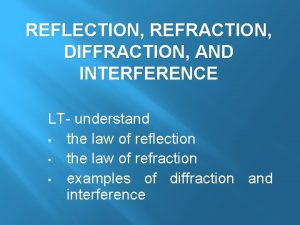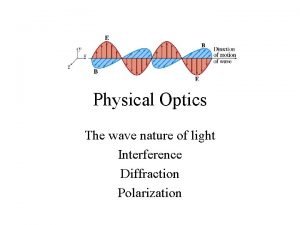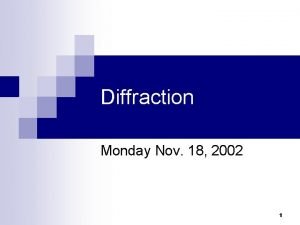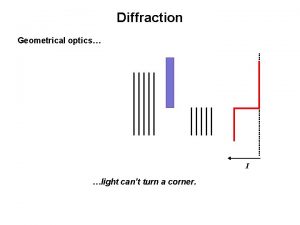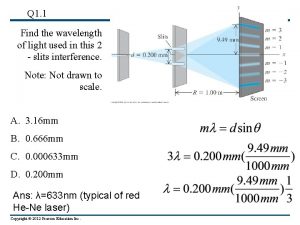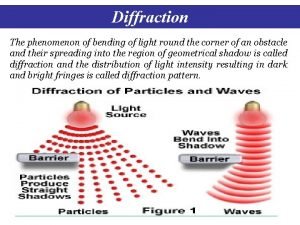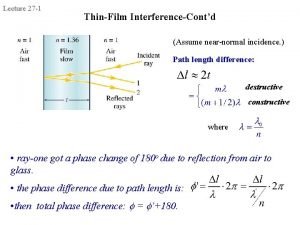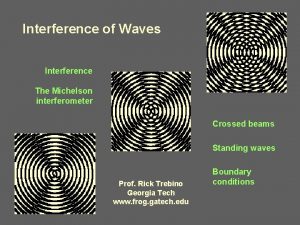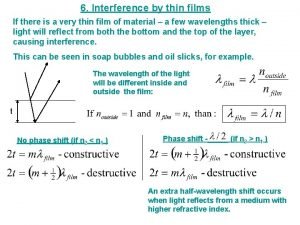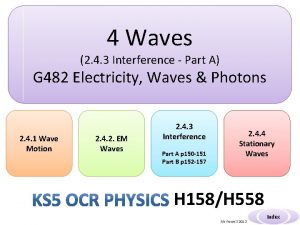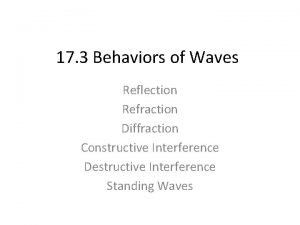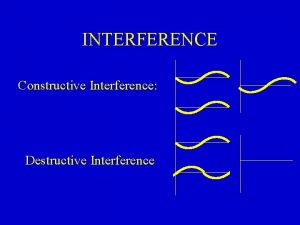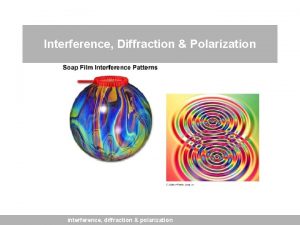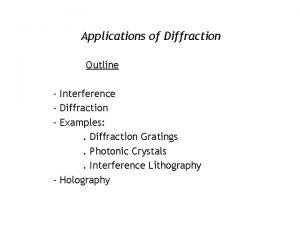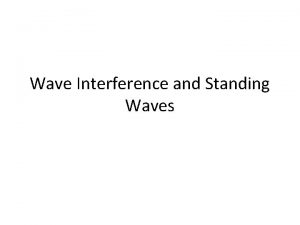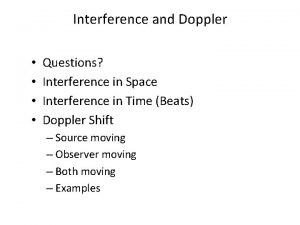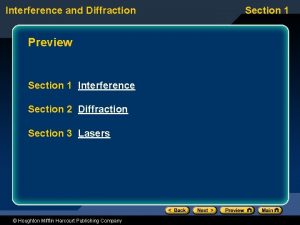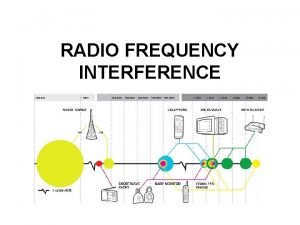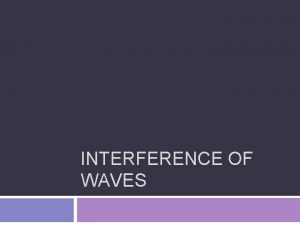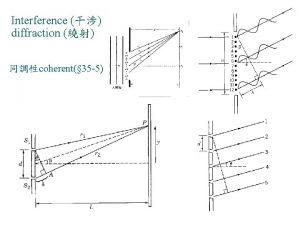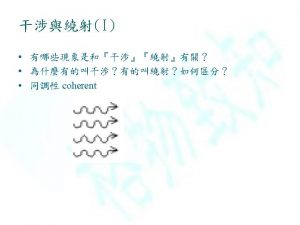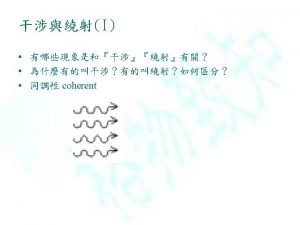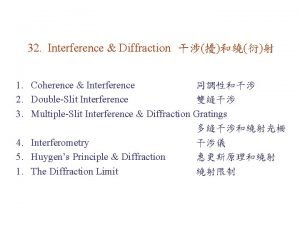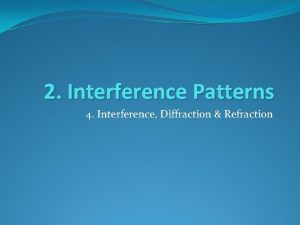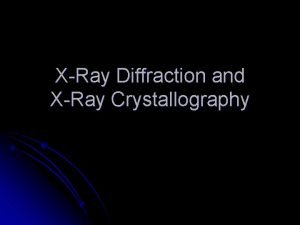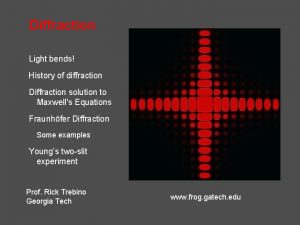Interference and Diffraction Chapter 35 36 Diffraction What






































- Slides: 38

Interference and Diffraction Chapter 35 -36

Diffraction What happens when a planar wavefront of light interacts with an aperture? If the aperture is large compared to the wavelength you would expect this. . …Light propagating in a straight path.

Diffraction If the aperture is small compared to the wavelength would you expect this? Not really…

Diffraction In fact, what happens is that: a spherical wave propagates out from the aperture. All waves behave this way. This phenomenon of light spreading out in a broad pattern, instead of following a straight path, is called: DIFFRACTION

Diffraction I Slit width: a q Angular Spread: q ~ l/a (Actual intensity distribution)

Huygen’s Principle Huygen first explained this in 1678 by proposing that all planar wavefronts are made up of lots of spherical wavefronts. .

Huygen’s Principle Huygen first explained this in 1678 by proposing that all planar wavefronts are made up of lots of spherical wavefronts. . That is, you see how light propagates by breaking a wavefront into little bits

Huygen’s Principle Huygen first explained this in 1678 by proposing that all planar wavefronts are made up of lots of spherical wavefronts. . That is, you see how light propagates by breaking a wavefront into little bits, and then draw a spherical wave emanating outward from each little bit.

Huygen’s Principle Huygen first explained this in 1678 by proposing that all planar wavefronts are made up of lots of spherical wavefronts. . That is, you see how light propagates by breaking a wavefront into little bits, and then draw a spherical wave emanating outward from each little bit. You then can find the leading edge a little later simply by summing all these little “wavelets”

Huygen’s Principle Huygen first explained this in 1678 by proposing that all planar wavefronts are made up of lots of spherical wavefronts. . That is, you see how light propagates by breaking a wavefront into little bits, and then draw a spherical wave emanating outward from each little bit. You then can find the leading edge a little later simply by summing all these little “wavelets” It is possible to explain reflection and refraction this way too.

Diffraction at Edges what happens to the shape of the field at this point?

Diffraction at Edges I

As The Wave Propagates Out Spherically Its Intensity Decreases . . . this happens with an edge too. . Diffraction places a finite limit on the formation of images

Double-Slit Interference Because they spread, these waves will eventually interfere with one another and produce interference fringes

Double-Slit Interference

Double-Slit Interference

Double-Slit Interference

Double-Slit Interference Bright fringes

Double-Slit Interference screen Bright fringes

Double-Slit Interference screen Bright fringes Thomas Young (1802) used double-slit interference to prove the wave nature of light.

Double-Slit Interference Light from the two slits travels different distances to the screen. The difference r 1 - r 2 is very nearly d sinq. When the path difference is a multiple of the wavelength these add constructively, and when it’s a half-multiple they cancel. P r 1 r 2 d q L y

Double-Slit Interference Light from the two slits travels different distances to the screen. The difference r 1 - r 2 is very nearly d sinq. When the path difference is a multiple of the wavelength these add constructively, and when it’s a half-multiple they cancel. P r 1 r 2 d q L y d sin q = m l bright fringes d sin q = ( m+1/2) l dark fringes

Double-Slit Interference Light from the two slits travels different distances to the screen. The difference r 1 - r 2 is very nearly d sinq. When the path difference is a multiple of the wavelength these add constructively, and when it’s a half-multiple they cancel. P r 1 r 2 d y d sin q = m l bright fringes d sin q = ( m+1/2) l dark fringes Now use y = L tan q; for small y: y bright = ml. L/d q L y dark = (m+ 1/2)l. L/d

P r 1 y r 2 d q L What is the field amplitude?

P r 1 What is the field amplitude? y r 2 d q L Phase is k(r 1 -r 2):

P r 1 What is the field amplitude? y r 2 d q L Phase is k(r 1 -r 2):

Example: Double Slit Interference Light of wavelength l = 500 nm is incident on a double slit spaced by d = 50 mm. What is the fringe spacing on the screen, 50 cm away? d 50 cm

Example: Double Slit Interference Light of wavelength l = 500 nm is incident on a double slit spaced by d = 50 mm. What is the fringe spacing on the screen, 50 cm away? d 50 cm

Multiple Slit Interference With more than two slits, things get a little more complicated P y d L

Multiple Slit Interference With more than two slits, things get a little more complicated P y Now to get a bright fringe, many paths must all be in phase. The brightest fringes become narrower but brighter; d L and extra lines show up between them.

Multiple Slit Interference With more than two slits, things get a little more complicated P y Now to get a bright fringe, many paths must all be in phase. The brightest fringes become narrower but brighter; d L and extra lines show up between them. Such an array of slits is called a “Diffraction Grating”

Multiple Slit Interference All of the lines show up at the set of angles given by: dsinq = (m/N)l (N = number of slits). Most of these are not too bright. The very bright ones are for m a multiple of N. We won’t worry about the math here, just look at the general form: S q

Single Slit Diffraction Each point in the slit acts as a source of spherical wavelets For a particular direction q, wavelets will interfere, either constructively or destructively. This is for a slit of width a. Result: This gives the angular spread ~ l/a. I

Example: Single Slit Diffraction Light of wavelength l = 500 nm is incident on a slit a=50 mm wide. How wide is the intensity distribution on the screen, 50 cm away? a 50 cm

Example: Single Slit Diffraction Light of wavelength l = 500 nm is incident on a slit a=50 mm wide. How wide is the intensity distribution on the screen, 50 cm away? a 50 cm

Example: Single Slit Diffraction Light of wavelength l = 500 nm is incident on a slit a=50 mm wide. How wide is the intensity distribution on the screen, 50 cm away? a What happens if the slit width is doubled? 50 cm

Example: Single Slit Diffraction Light of wavelength l = 500 nm is incident on a slit a=50 mm wide. How wide is the intensity distribution on the screen, 50 cm away? a What happens if the slit width is doubled? The spread gets cut in half. 50 cm

The Diffraction Limit Diffraction therefore imposes a fundamental limit on the resolution of optical systems: Suppose we want to image 2 distant points, S 1 and S 2 through an aperture of width a: The image separation is D ~ Lsinq ~ Lq. The image blur is B ~ Ll/a L S 1 q D S 2 To resolve individual points, we want: separation > blur so q > l/a B
 Diffraction and polarization
Diffraction and polarization Retroactive vs proactive interference
Retroactive vs proactive interference Retroactive interference
Retroactive interference Reflection refraction diffraction interference
Reflection refraction diffraction interference Interference and standing waves
Interference and standing waves Limit fit tolerance
Limit fit tolerance Repressed memories
Repressed memories Interference definition
Interference definition Frequency units
Frequency units Extent of researcher interference
Extent of researcher interference Constructive and destructive interference
Constructive and destructive interference Fresnel and fraunhofer diffraction
Fresnel and fraunhofer diffraction Diffraction by circular aperature
Diffraction by circular aperature When a wave strikes an object and bounces off
When a wave strikes an object and bounces off Diffraction through single slits derivation
Diffraction through single slits derivation Principal maxima and secondary maxima
Principal maxima and secondary maxima Reciprocal lattice concept in x ray diffraction
Reciprocal lattice concept in x ray diffraction Diffraction and scattering
Diffraction and scattering Cell dragging in wireless communication
Cell dragging in wireless communication Interference phenomenon
Interference phenomenon Interference competition
Interference competition Non contrived study setting example
Non contrived study setting example Biaxial interference figures
Biaxial interference figures Melatope mineralogy
Melatope mineralogy Draw the interference pattern for the two waves
Draw the interference pattern for the two waves Interference in thin film
Interference in thin film Exploitative competition
Exploitative competition Fázový rozdíl
Fázový rozdíl Michelson interferometer formula
Michelson interferometer formula Interference by division of amplitude
Interference by division of amplitude Interference competition
Interference competition Dairyland ssd
Dairyland ssd Gause
Gause Constructive interference formula
Constructive interference formula Interference in thin film
Interference in thin film Interference of microwaves
Interference of microwaves Interference wave behavior
Interference wave behavior Work-home interference
Work-home interference Psychological noise.
Psychological noise.



